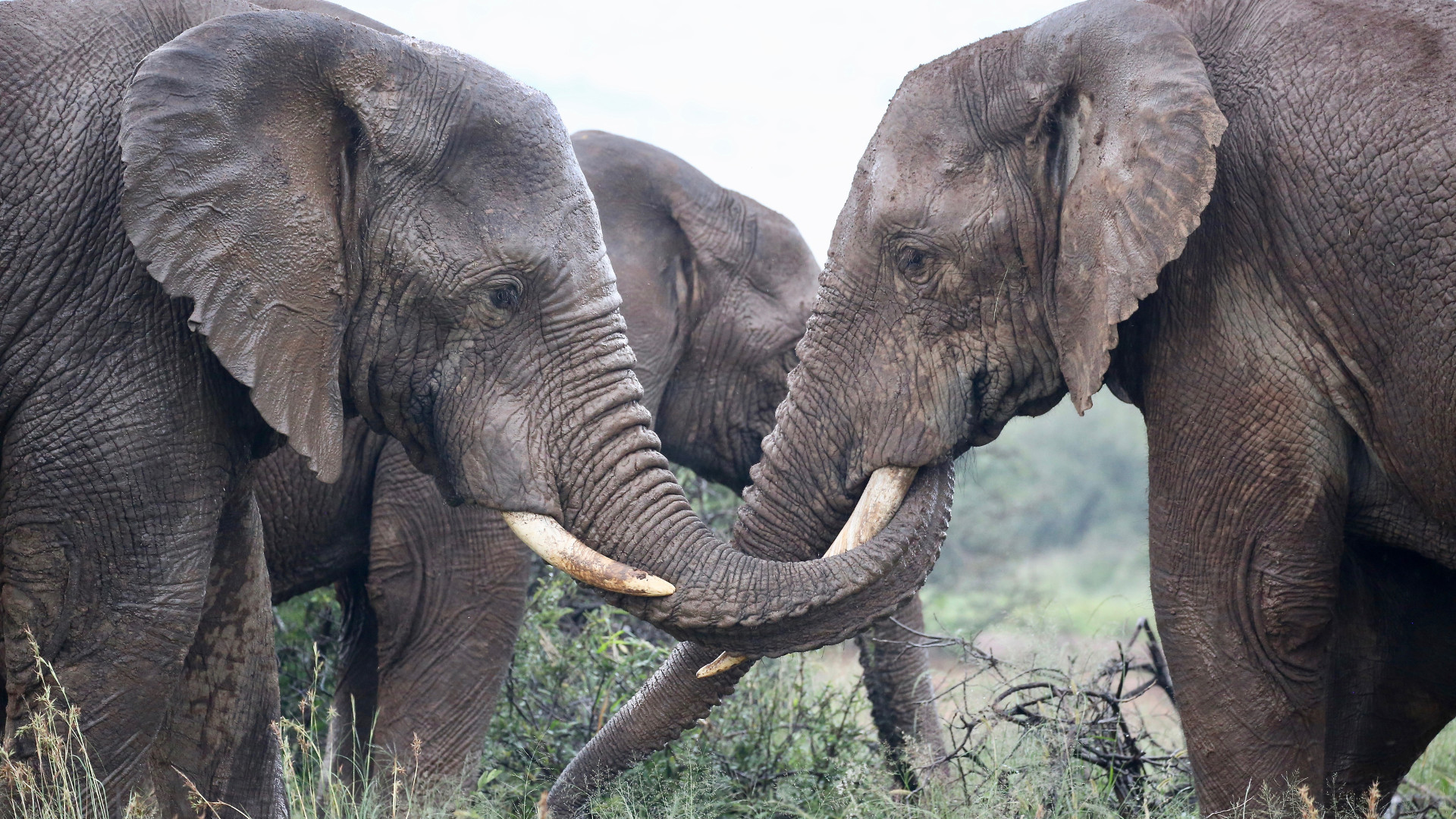President Donald Trump recently made headlines when he said he would not allow trophies from legal elephant hunts to be imported into the United States. Although this was the right move, it isn’t enough to stop elephants from being slaughtered into extinction.
Amazing creatures with a life expectancy of 60 to 70 years, African elephants lead complex emotional and social lives. They carry their babies for two years — the longest gestation of any mammal. Their calves then nurse for several years, and family connections remain close. Not surprisingly, as the largest land mammal, weighing 10,000 pounds or more when adults, the elephant also has the largest brain of any land animal.
But tragically, their brains and size offer no protection against those who kill them indiscriminately. In repulsive, incomprehensible and immoral acts of poaching, these highly intelligent, sentient beings have been poisoned and then dismembered for their tusks, which are turned into ivory trinkets and speculative investments for the wealthy elite.
Elephants By the Numbers
These heinous crimes are abominations against the species (and other wildlife, which can suffer or die from the poison put in the environment), and they are ongoing — in both legally protected and unprotected areas. There’s no safe haven for elephants in Africa. Between 2010 and 2012, poachers killed 100,000 African elephants in numerous gruesome ways, according to a 2014 study published in the Proceedings of the National Academy of Sciences.
Today, more African elephants are murdered for their ivory than are born. This illicit killing is driving the extirpation-level decline of African elephants, which numbered as many as 26 million in the 1500s — just 500 years ago, a mere blink in time — when they roamed most of the African continent. In 2016 the Great Elephant Census, funded by Microsoft cofounder-turned-environmentalist Paul G. Allen, found that the population had plummeted to 352,271 elephants, representing a 93 percent decline in the 18 countries surveyed.
As with all illicit trafficking — be it in drugs, humans or wildlife — there are tremendous costs. As a keystone species, elephants are essential to the ecosystems in which they live, playing their part in a complex structure that affects other plant and animal life. Their elimination disrupts a balance that evolved over millions of years.
There’s a very human cost to the assault on elephants as well. Park rangers and conservationists put their lives on the line daily, and many have died protecting wildlife. Earlier this month Esmond Bradley Martin, one of the world’s top ivory and rhino horn trafficking investigators, was murdered in Kenya. There is speculation that his murder was linked to his work. Last year another well-known elephant conservationist, Wayne Lotter, was murdered in Tanzania. Again, suspicions were that the murder was connected to his work.
More Action Before It’s Too Late
“It’s clear we need an immediate, effective, large-scale approach to conservation,” Paul Allen has said. “Otherwise, we risk elephants disappearing from the continent for good.” But whether that’s happening fast enough to save the elephant is questionable. In recent years — as governments, organizations and communities argue over threat level designations, rehash past transgressions of colonialism, burn ivory stockpiles and debate how to eliminate ivory demand — elephants have continued to be killed in alarming numbers.
As an armchair conservationist closely following these developments, I’m flummoxed. With such small numbers of elephants remaining in Africa, it seems the global community must come together much more effectively to protect these animals. To kill the trade, this means more outreach in China and Asia to educate the end-users of ivory of how their purchases are killing a species, and more work with local communities to deploy more boots on the ground to guard elephant herds using technology against well-organized criminal syndicates.
It means working to better educate local communities about elephants and other wildlife, and creating economic opportunities that would discourage local poaching and encourage people to be defenders of wildlife. While viewed globally, protecting elephants, obviously, must happen at a very local level. American Scientist reported on a study that looked at areas of Angola, Botswana, Namibia, Zambia and Zimbabwe, countries which are part of Africa’s Kavango-Zambezi Transfrontier Conservation Area. While the situation is reported as stable for elephants, human residents are challenged. With unemployment at more than 90 percent in parts, and farming-elephant conflict putting people at risk, locals feel left out of input into conservation plans and tourism opportunities. The study’s authors outline a case where the needs of the community were inadequately addressed in conservation plans.
Policy Responses
Former Colorado Governor and outspoken policy critic Dick Lamm has said governments are most responsive when situations reach crisis. Elephants are in real crisis — the time for more countries worldwide to respond is now. For example, last month major ivory market Hong Kong announced it would end the legal sale of ivory in a four-year phaseout — a long timeframe for elephants in the 11th hour. Accompanying this step, which came on the heels of China’s earlier announcement to ban legal ivory sales, are harsher penalties for smugglers, an important component as battening down the hatches on legal sales is likely to drive black-market sales.
These announcements from China and Hong Kong, the world’s most voracious ivory consumers, have been called a “major game-changer” by conservationists. With them, there’s optimism that Laos, Thailand and Vietnam, also large ivory dealers where demand is increasing, will end their legal markets. Without a broad commitment to ending the trade — legal and illegal — eliminating the devastation will continue to be difficult.
Prior to this, in 2016, 182 countries signed a legally nonbinding agreement calling for the end of all legal ivory markets. In the United States, the world’s number-two market for illegal ivory, a nearly complete ban on the commercial sale of African elephant ivory went into effect under the Obama administration. The ban was temporarily overturned for Zambia and Zimbabwe under the Trump administration last November, but President Trump confirmed in January that the ban would remain in place. Blaming “a very high-level government person” for the sleight of hand on lifting the ban, Trump said, “As soon as I heard about it, I turned it around.”
Surprisingly, the United Kingdom remains a very large ivory importer and exporter. It has not shut down its legal ivory trade, despite 85 percent public support to end it.
The twin evil to poaching is legal hunting of elephants in many countries, including Cameroon, Mozambique, Namibia, South Africa, Tanzania, Zambia and Zimbabwe. Given the precipitous drop in elephant numbers, what we know about the social structures of animals and that more elephants are killed than being born, among so many other points, how hunting of elephants can align with heading off extinction is counterintuitive, and raises the question of when, or if, elephant “trophy hunting” will become illegal.
Change, Act
Laws and law enforcement to curb the business of dealing in animal body parts are essential. But beyond that, unless more people embrace the rights of these animals to exist and have sufficient habitat to thrive in peace, then the threat of extinction will remain.
What a contribution to the world it would be if the outrage directed at such things as proposals to have a parade in the U.S. could be redirected — and generate real change — to ending the genocide against elephants, and many other species… if the rich trophy hunters worldwide contributed the $45,000 per “adventure” that they pay to kill rare animals instead to actual conservation efforts and programs for sustainable African communities in balance with local wildlife… if those who chose to spend $3,000 for a Super Bowl ticket, or a designer handbag, instead wrote a check for elephants… if Paul Allen’s large-scale conservation idea for Africa could come to fruition… if Homo sapiens actually earned “the thinking man” claim through a change in actions.
Oh, utopian thinker!
In the current age of mass extinction in which we live, and that humankind is driving, John Donne’s oft-quoted “Any man’s death diminishes me, because I am involved in mankind” is as apt today as when it was written centuries ago, with one deletion, to read: “Any death diminishes me.”
The war on elephants isn’t just an Africa problem; it’s a global crisis to solve. Among the 7.6 billion people on our green planet, there are enough of us who, working collaboratively, can save the elephant. We must challenge more nations to follow the lead taken by the Obama administration and reconfirmed in the Trump administration to do better and ban the importation of elephant ivory. And we must advocate loudly for putting an end to legal elephant hunting and for committing essential resources to destroying crime syndicates that deal in animal body parts and extinction.
Update: After this essay was published, the Trump administration announced it would start to allow the import of elephant hunting trophies on a “case-by-case basis.”
© 2018 Maria Fotopoulos. All rights reserved.
The opinions expressed above are those of the author and do not necessarily reflect those of The Revelator, the Center for Biological Diversity or their employees.


